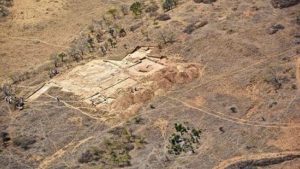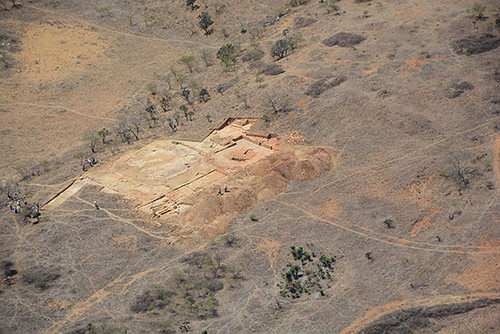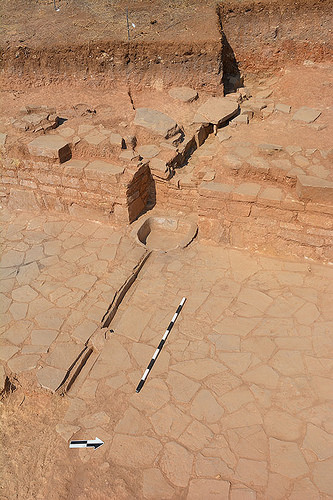
San Martín Tilcajete is a small rural town about 14 miles from the city of Oaxaca in southwestern Mexico. It doesn’t swirl with the same bustle of its much larger neighbor miles away, but, like the city of Oaxaca, it thrives in great measure on tourism. People come thousands of miles to see and buy the town’s alebrijes, wood carvings of creatures, some real, some imaginary, painted with bright colors in intricate patterns. One can see them displayed atop white-clothed tables arrayed in open-air weekly markets, their creators eager to show their craft and make the sale. During tourist season, which in Mexico encompasses much of the year, these markets are popular destinations.
But San Martín Tilcajete is also known for something else. Rich in its traditional and historic Zapotec culture, it also sits astride some very ancient ruins. The archaeological site of El Palenque (not to be confused with Palenque, the ancient Maya site), an ancient Zapotec center at least as old as the early Republic of Rome far away in the Old World, gives the town an extra-special draw. That is because here, as long ago as about 100 to 300 years BCE, a king ruled a polity that helped to set the pace for the foundations of state-level civilization long before the great Aztecs ruled in similar fashion further north in present-day Mexico City — and more than 1500 years before the Spanish conquistadores brought the Aztec capital of Tenochtitlán to ruin.
Digging El Palenque
Archaeologists have been excavating El Palenque since 1993. But arguably the most compelling features of the site began to emerge later, from excavations conducted from 2009 to 2011, when Elsa Redmond and Charles Spencer of the American Museum of Natural History (AMNH) and their team encountered the remains of what they interpreted to be a temple precinct dated by radiocarbon techniques to between 300 and 100 BCE. The oldest such precinct yet discovered in the Valley of Oaxaca, it consisted of a walled enclosure on the east side of the site’s main plaza, containing three temples featuring multiple rooms, and two specialized residences and ritual features and activity areas, all suggesting the operation of a specialized priesthood staff. Reported in detail in a 2013 paper published in the Proceedings of the National Academy of Sciences (PNAS), the discovery revealed a very early specialized full-time priesthood class working within a temple precinct with features or characteristics previously known to exist among much later Mesoamerican societies, such as the Aztecs further north. It was a remarkable discovery, adding another finding to scholarly knowledge about the development of archaic society of early Mesoamerica, particularly in the Valley of Oaxaca.
The Palace
At least as remarkable, if not more so, however, was the discovery of an ancient royal palace complex at the same site, dated by associated radiocarbon samples and excavated ceramics to the same time period, as reported in a recent 2017 PNAS paper by Redmond and Spencer and summarized in a related news release by the AMNH. In that excavation, Redmond and Spencer uncovered palace complex structures and features that extended over an area of about 2,790 square meters situated on the north side of El Palenque’s main plaza. As they excavated, architectural and spacial features began to emerge that revealed a complex consisting of both governmental/administrative structures and an adjoining residential complex, linked by a central staircase and underlaid by a sophisticated water management system.
At the forefront of the complex was what Redmond and Spencer describe as a colonnaded entry courtyard, designated as the Colonnaded Court, which was accessed from the centerline of the northern edge of the main plaza by a broad staircase. They knew it featured columns because they uncovered the remains of columns that originally characterized the court, which “survived in the carbonized deposits on the burned earthen floor of the corridor”* — a clear sign that the complex, or at least part of the complex, had once succumbed to a fiery end. Within the courtyard they recovered fragments of ceramic braziers and urns which, according to Redmond and Spencer, “reflect the lighting of braziers and the attendant ceremonies celebrated there”*, a clue to the functions performed in this part of the palace complex and as a place where official visitors and officials of the El Palenque polity would have assembled.
Excavators uncovered stairways and corridors that appeared to lead to other pavements and buildings associated with the complex, including a central staircase leading clearly to what the site investigators interpret to be the ruler’s residential palace, situated on the highest ground and overlooking the plaza. The relative location and placement of the residential palace appeared to be consistent with similar attributes found at palaces of later Mesoamerican states, according to the site investigators. Here, excavations also uncovered a passageway that led to a flagstone-paved court, designated the East Pavement, which was flanked on three sides by low stone masonry platforms. The pavement, notes Redmond and Spencer, may be the remains of the ruler’s throne hall, “where he received officeholders, petitioners, and emissaries who were granted an audience with him”.* Here, human cranial fragments were also found, suggesting a consistency with the “ritual sacrifices practiced by [the later] 16th century Zapotec rulers in reaching and carrying out decisions on important matters,”* indicating a practice that apparently had very early roots in the formation of archaic society in this region. Within the privately appointed residential palace itself, eight rooms were uncovered which displayed evidence of differentiated function and size, including what may have been the ruler’s bedroom. Also associated with the palace were spaces or structures suggesting a storeroom, kitchen, and pantry.
Significant to the excavation results was the absence of any tomb within the palace complex, consistent with the practice of later Mesoamerican ruler burials, another practice that seems to have had early beginnings as suggested by the El Palenque evidence.
_____________________________________
Areal view of excavated remains of the El Palenque royal palace. Image courtesy Elsa M. Redmond and Charles Spencer
_________________________________________________________
Water shrine, where a stone-lined drain descending from ruler’s residence supplied rainwater to cistern. Image courtesy Elsa M. Redmond and Charles Spencer
____________________________________________________
What it all means
“There is evidence that the residential palace was built in a single construction effort by at least three different work groups, in a preconceived and centrally directed effort,” write the authors of the PNAS paper.*
Redmond and Spencer’s statement is one among a number of conclusions that support the suggestion that early archaic state formation in the Oaxaca Valley had reached a relatively advanced level already in the first few centuries BCE. El Palenque was a centrally run, hierarchically structured society with organized or established groups of specialized laborers and crafts people. Human remains recovered in the palace’s throne hall suggested a ruler who exercised ultimate authority, a key power demonstrated by the rulers of later Mesoamerican states as they executed death sentences and presided over human sacrifices. Concluded Redmond and Spencer in their report: “The palace underscores the El Palenque ruler’s ability to amass considerable manpower for its construction. The palace’s differentiated ground plan reflects the centralized, hierarchical, and internally specialized administration of a state. The radiocarbon dates associated with the palace complex span the Late Monte Albán I phase of the Late Formative period (300–100 BC), a time period for which there is considerable evidence of state organization in the Valley of Oaxaca. This 2,300-year-old palace is the oldest multifunctional palace excavated to date in the Valley of Oaxaca and is a key indicator of the early state society that emerged there at this time.”*
But perhaps most significant of all, the discoveries at El Palenque underscore the emerging reality that timetables on early state formation in Mesoamerica seem to be increasingly pushed back to earlier centuries, and that, at least in the Valley of Oaxaca, Mexico, foundations were being laid for the much later Mesoamerican societies or kingdoms that we have seen documented by the first Europeans who arrived in this part of the world some 500 years ago.
_______________________________
The Zapotecs
Although El Palenque is now thought to have been the center of an independent state, it was also one of a number of ancient centers that made up the Zapotec civilization, which emerged around 500 BCE in the Valley of Oaxaca, developing out of early agricultural communities. The civilization became the dominant collection of polities within the Valley, and actually expanded beyond its Oaxaca Valley borders as an empire, stemming in part from extensive trade links with the Olmec civilization to the east near the Gulf coast, Teotihuacan to its north, and the Maya civilization to its south. Best known among the Zapotec centers is Monte Albán, which enjoyed capital status as the residential, ritual and economic center of the Zapotec civilization for centuries, replacing the first ancient center, San José Mogote, between 500 and 450 BCE. It is also known to have been the burial site for Zapotec rulers for more than a thousand years. Monte Albán is thought to have supported a population of about 25,000 people at its height but also dominated over 1,000 other centers or settlements in the Valley. Redmond and Spencer suggest that El Palenque, as an independent polity, resisted Monte Albán’s rule or dominance for a time, before finally acquiescing to its rule by the first century BCE, with evidence showing that it may have been after military conquest.
_____________________________________
Based on their research of later documents describing the nature of the later Zapotec rulers, Redmond and Spencer paint a vivid portrait of Zapotec rulership, which may form the basis for understanding the much earlier Zapotec rulers at El Palenque:
“Ethnohistoric data on 16th century Zapotec palaces in Oaxaca are not as detailed, but they share some of the architectural and organizational criteria of Aztec palaces. The palace of a supreme Zapotec ruler was a quihuitào or “beautiful royal palace”. The Relaciones Geográficas that Spanish officials compiled for Zapotec towns between 1579 and 1581 offer some brief de- scriptions. Like their Aztec counterparts, Zapotec rulers resided and ruled in their palaces. One patio of the palace had a meeting hall where the ruler’s most trusted councilors received visitors, officeholders, and petitioners bringing matters to the court. The councilors presented the issues brought before them to the ruler in a separate patio of the palace. In those instances when the ruler granted an audience in his throne room, the visitors observed strict rules of decorum as they addressed the ruler seated on his mat. The ruler reached most decisions after practicing divinatory rituals and offering sacrifices. Juan de Córdova’s dictionary lists the Zapotec terms for the royal court, the meeting halls, the ruler’s throne, and the many lords and diverse officials who assembled there.”*
______________________________________________________
*Redmond, Elsa M. and Spencer, Charles S., Ancient palace complex (300 — 100 BCE) discovered in the Valley of Oaxaca, Mexico, www.pnas.org/cgi/doi/10.1073/pnas.1701336114.
______________________________________________________







